Welcome to a new series! I’ve been writing Cooking with the Silent Stars for some time, which covers recipes attributed to silent era celebrities, but I wanted to try my hand at recreating the dishes shown in the silent films themselves.
This post is my contribution to the Food in Film Blogathon hosted by Silver Screenings and Speakeasy. Be sure to read the other posts but be careful, this event may be hazardous to your waistline!
I traditionally launch new series with things that are related to The Sheik but I decided to shine the spotlight on one of Mary Pickford’s best films this time around. In Daddy Long Legs (1919), Pickford plays a spunky orphan who goes to college and dreams of becoming a published author.



The orphanage is not quite Dickensian but it is unpleasant and one of the worst aspects is the steady diet of prunes. Pickford leads a prune uprising, which quickly fizzles and it’s back to prunes three times a day.
For this experiment, I used a stewed prune recipe from the 1918 edition of the iconic Boston Cooking-School Cook Book originally penned by Fannie Farmer (and the last edition completely penned by her before her death in 1915). This was THE cooking bible for American homes of the era. The recipe is as follows:
Wash and pick over prunes. Put in a saucepan, cover with cold water, and soak two hours; then cook until soft in same water. When nearly cooked, add sugar or molasses to sweeten. Many prefer the addition of a small quantity of lemon juice.
Farmer recommends the prunes as a topping for hot cereal with sugar and cream but the orphans were eating their prunes straight so I opted to do the same. I also pressed my father into service as a taster because he ate and enjoyed stewed prunes as a child.
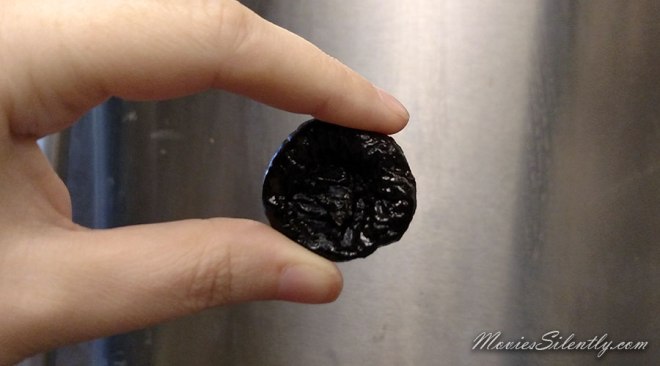

The prunes were pitted (alas, it’s relative hard to find prunes with pits in my neck of the woods) but I soaked them in juuuuust enough water to cover. Farmer leaves everything to taste, I added two teaspoons of sugar to about a cup of prunes. (I rather like molasses but I had an unfortunate incident with a broken jar and need a break from it to recover. Cleaning up molasses and glass is no joke!)

I cooked the prunes over medium-low heat, stirred them occasionally and took them off the stove once the water had reduced to the consistency of maple syrup. I added the lemon juice midway through cooking. “A small quantity” is a relative term. I used a fair portion of half a lemon because my whole family prefers things on the tart side.
Here they are:
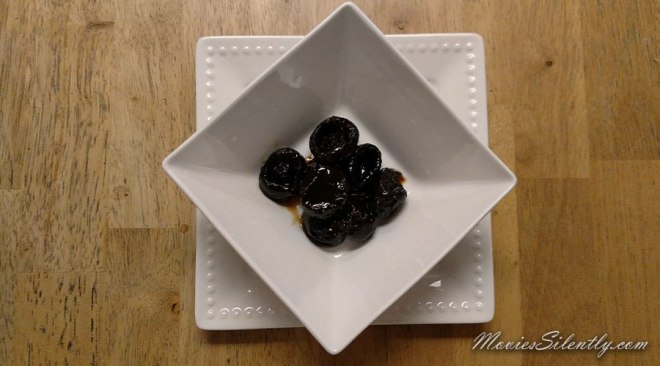

Verdict: Deeeelish! I’ve always liked prunes; they’re basically bigger, better raisins and they produce a warrior’s drink. Plumping dried fruit is a classic way to add flavor, there’s just no way to lose. Stewing prunes in sugar and juice amplifies their rich flavor and produces an equally rich syrup that can be drizzled in that sexy spiral all the kids are using these days. Stewed prunes are to plums what baked apples are to raw apples, if that gives you an idea of what to expect.
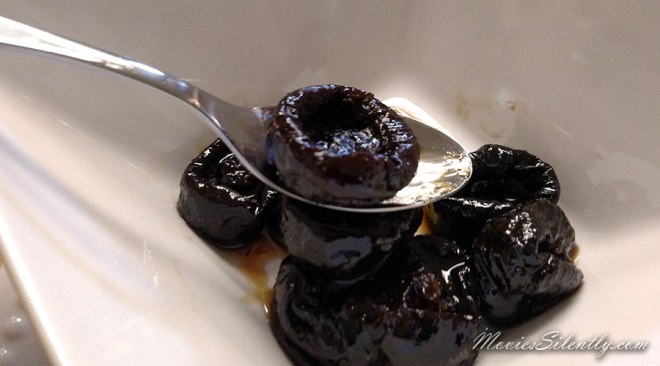
My father said that they were the best stewed prunes he had ever had, so they have an authentic seal of approval from a veteran eater of the dish. (Biased? Never! Seriously, though, he loved the extra lemon juice.) I plan to make them again and eat them on oatmeal with cream and sugar, as Fannie Farmer suggests. In addition to everything else, they are ridiculously packed with nutrients.
Oh, and keep in mind before consuming that the certain thing that prunes are famous for doing is a scientific fact. Be careful out there, kids!

I found the prunes to be quite tasty. Really, how can you go wrong with plumped up dried fruit and lemon juice? This leads us to the big question: Why the heck were they so unpopular? Why would Mary Pickford riot over them in Daddy Long Legs? There are several answers.
Quality or Lack Thereof

I purchased my ingredients at a grocery store but the prunes served to orphans and immigrants were sometimes of such low quality that scandal ensued. Further, I stewed my recipe with care and tasted to make sure that the ratio of sweet and sour were to my taste. An orphanage like the one portrayed in Daddy Long Legs would not likely put that much care into food preparation.
A word that keeps cropping up in vintage texts when stewed prunes are mentioned is “watery” and is it any surprise. A 1920 issue of the Herald and Presbyter describes orphanage prunes:
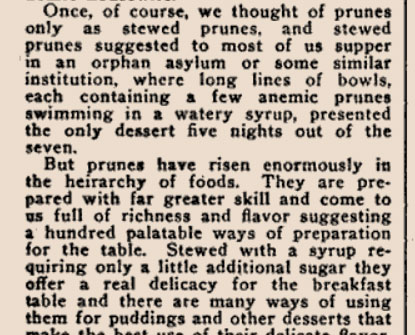
So the “prunes” served in Pickford’s film were really more water than anything else with precious little sugar and likely no lemon juice. Diluting is a classic way of making food dollars stretch but it also can render the dish inedible, which seems to be what happened in orphanages at such a rate that the badness of the dish is casually mentioned as common knowledge.
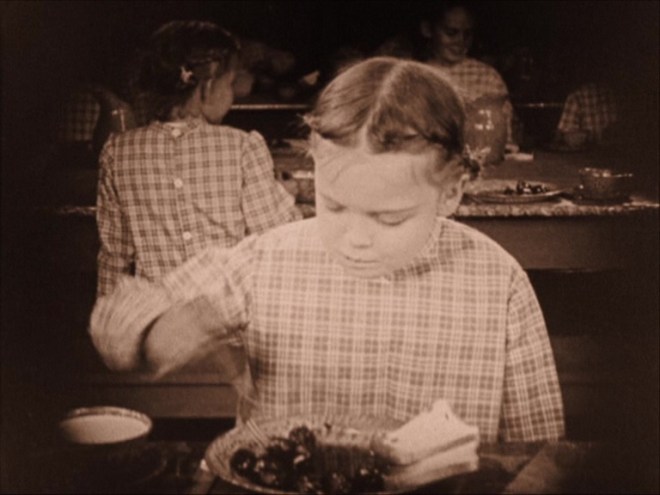
The film itself backs up this notion. Water and lots of it!
Quantity

Eating anything day in and day out can take a toll, especially if the food is badly prepared and strong-tasting. I think back to the watery coleslaw of my school lunch days (I was taken out after fifth grade, hallelujah!) and how it turned me off to all slaws for years. And I had the option of bringing my lunch AND the slaw was only three times a week. Three times a day? And forced to eat it? I’d be rioting too.
First world problem? Maybe. But when meals are prepared without any attention paid to the happiness of the eaters, no good can result. And studies show that when schoolchildren are fed quality, healthy lunches, they do better academically.


Social Stigma

Prunes were cheap, nutritious and easy to store, which made them ideal for mass feeding. Prunes were stuffed down the throats of immigrants and orphans and who can blame them for being resentful? My father was drafted for Vietnam and he still can’t look a can of Spam in the face. He loves his tinned meats (specifically, he loves his Vienna sausages) but that spiced ham brings back memories of an unpleasant nature.
For an orphan or immigrant growing up in the early twentieth century, prunes would have likely reminded them of being poor and the target of discrimination and abuse. Unpleasant associations, to say the least, and even people who were raised in comfortable situations would be aware of the prune’s ubiquity in industrial settings.
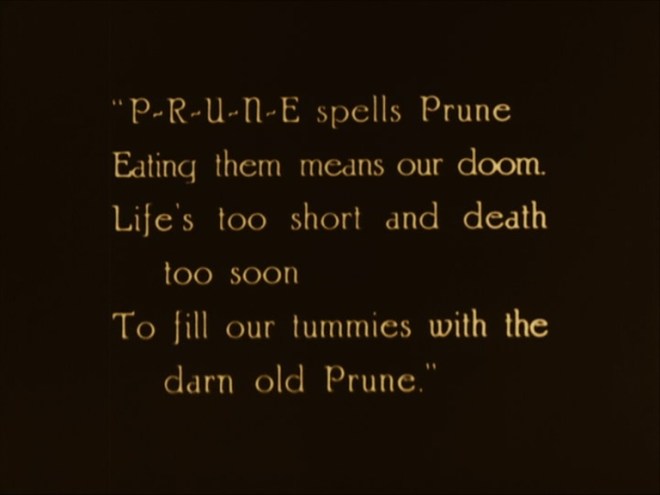
That’s not to say that the prune was utterly shunned. Classic cookbooks are full of recipes for things like prune whip, prune cake filling and prune pie. It’s just that you probably wouldn’t bring out a bowl of stewed prunes to impress the boss. It’s also worth noting that the dislike of prunes is not universal; they hold a place of honor in French cuisine.
Today in the United States, prunes are actually pretty pricey and the foods associated with poverty include lots of pasta, processed meats and cheeses and white bread. Anybody who has found themselves short of cash before payday has eaten their share of instant ramen and the contents of a grocery basket say much about somebody’s economic status. Our eating habits seem to be as stratified as they were when Daddy Long Legs was released, just replace prunes vs. caviar with mac n’ cheese vs. molecular gastronomy.



Money can’t buy good taste, of course, and plenty of people manage to eat well on a frugal budget but once a food is associated with a negative stereotype, it’s hard to return it to public favor. It has been done (Brussels sprouts) but it takes work or celebrity endorsement. Or bacon. Renaming prunes “dried plums” was attempted but the Sunsweet fruit that I purchased for this project was just labeled plain old prunes. Own yourself, I say, and be a proud prune.
Well, that’s it for the first Eating the Silents. What did you think? Are there any silent movie meals you’d like to see prepared? Let me know in the comments!
***
Like what you’re reading? Please consider sponsoring me on Patreon. All patrons will get early previews of upcoming features, exclusive polls and other goodies.

I like this new series. I hope it’s a “regular” part of Movies Silently. Seriously though, you are making modern prune eating sound good. The history behind the negative view of prunes was interesting.
My dad has a problem with macaroni and pastas in general. He associates them with a rough part of childhood in SE Europe.
Yes, if you have to eat something day in and day out because there’s nothing else, surely it’s difficult to consume them later.
I, too, love stewed prunes, but they are naturally high in sugar, so a healthy serving is quite small. (And it never occurred to me to add sugar! Just thinly sliced lemon.) My parents, influenced by the ads and health fads of their youth in the 1920’s, were obsessed with “regularity.” I wish they had taken the stewed prunes route! Orphans and well-cared for children alike dreaded daily doses of castor oil, or black-strap molasses, or castoria, or syrup of figs, and (worst of all for me) Phillips Milk of Magnesia. Too bad people didn’t realize that the bland white bread we ate instead of the whole grains associated with “peasant food” was a big part of the problem! (My parents served plenty of fruit and vegetables, but in the 1940s and fifties, those foods were usually canned. Frozen vegetables in the fifties seemed miraculous — we could eat lightly cooked veggies all year round!)
I think the addition of sugar is more for texture than anything else, it does produce a beautiful sauce. Yes, with that low fiber diet, it’s no wonder regularity was a fixation.
My poor mother was a victim of castor oil and cola syrup. She still can’t drink Coke and she is a stickler for fiber: fresh fruit and veggies, whole grains, the whole shebang.
Stewed prunes are wonderful. I have never understood the stigma or the making faces at the thought of eating them. First, they are dried fruit, sweet and yummy. Softer than your average dried apricot right out of the bag. Second, I stew them just covering with water, boiling for about 15 minutes, then covering until they cool. Never have I added sugar as they are pretty darn sweet on their own. I will try lemon juice, next time. I love them on yogurt or with a little half & half, yummers/
Yes, I always lumped prunes in with all the other dried fruits that I have always snacked on. It wasn’t until the “dried plums” thing that I realized there was even an issue!
This is shaping up to be a really interesting and entertaining new MS series. Love the first installment!
A friend whose family hails from Montreal makes wonderful hors d’oeuvre trays of prunes and figs stuffed with soft cheeses. They are gone in a flash when she brings them over for a party or dinner we’re throwing. Have to admit, though, I cannot abide prune juice, really phobic about it and the source for me, like many in this thread, is having to drink so much of it while growing up. It was considered a trusted family remedy along with things like ginger root tea. Can’t drink that anymore either though love ginger in all other forms!
Re: silent food suggestions- still putting in a plug in for Mabel’s biscuits from Fatty and Mabel Adrift 😉
Thank you so much! I would be all over that prune and fig appetizer, yum!
Thanks for the plug 🙂
I can’t believe I’m saying this…but you have sold me on stewed prunes. Now, I say that not having ever tried them – I was just going by what other people said, who probably never tried them either.
“Daddy Long Legs” sounds like a terrific film besides. I don’t know many of Mary Pickford’s films, but she always seems to give a person their money’s worth judging by what I’ve seen so far.
Thank you for joining the blogathon, and for sharing your secret for tasty stewed prunes! 🙂
Whoohoo! Glad to hear it and thanks for hosting. 😀
Enjoyable blogathon entry! And you’re a braver soul than I am. Prunes, yecch!
Thank you! I am a huge dried fruit fan, so there was no bravery involved 🙂
The “one darn prune after another” title card is one of my favorites. I want it on a sweatshirt. I like prunes, but not stewed prunes. We had them on Mondays and Fridays at the boarding school I attended for two long years. They looked unprepossessing in the dish – cooks didn’t garnish anything – and they tasted strangely of mouthwash. Yours were probably better.
Yes, it sounds like it wasn’t prunes so much as BAD prunes that got everybody upset.
I love Aunt Mary but the thought of stewed prunes…. ewhh! You are so brave Fritzi to try out all these dishes – love your bravery!!
Thank you so much!
Poor little orphants! Their prunes were the gruel of fruit.
Yeah, it’s a wonder there weren’t more prune uprisings.
Proud prune fan here, the giant raisin comparison is exactly how I’ve always seen them. Watered down like that though, they’d get revolting. Liked this a lot, will make for an interesting series, and thanks for being part of the blogathon, always great to have you along!
(waves to fellow prune fan)
Thanks so much for hosting!
What a fantastic series! I never imagined learning about prunes would be more interesting than 90% of the classes I took at college.
And your dish seems delicious. Your father is lucky to be your taster!
Thank you so much! 😀